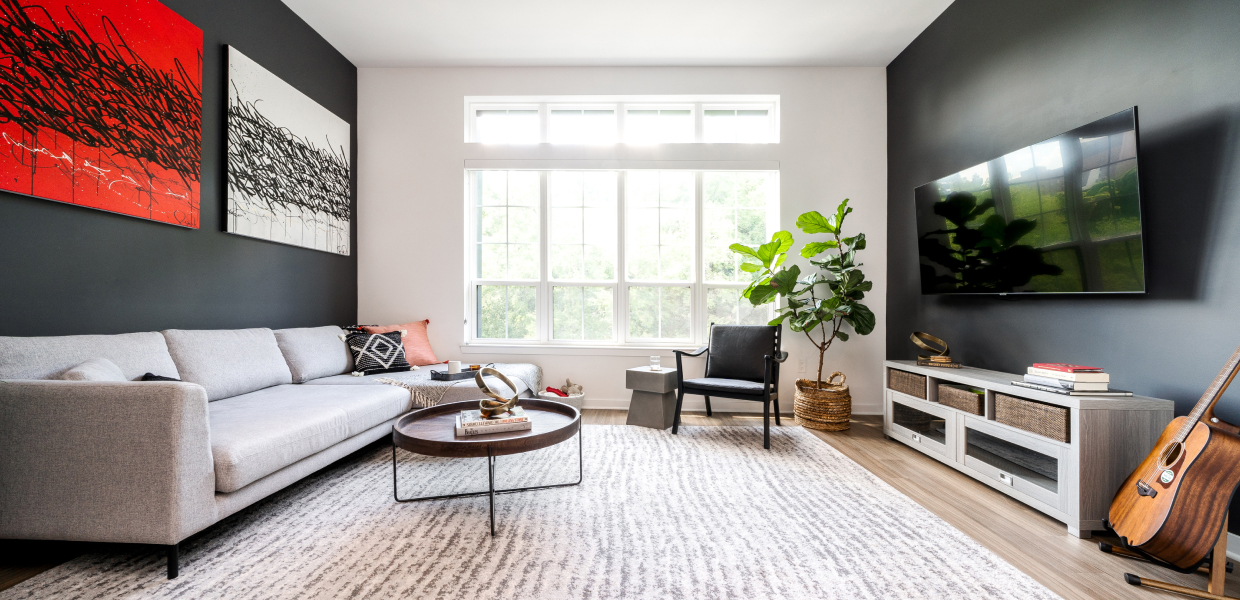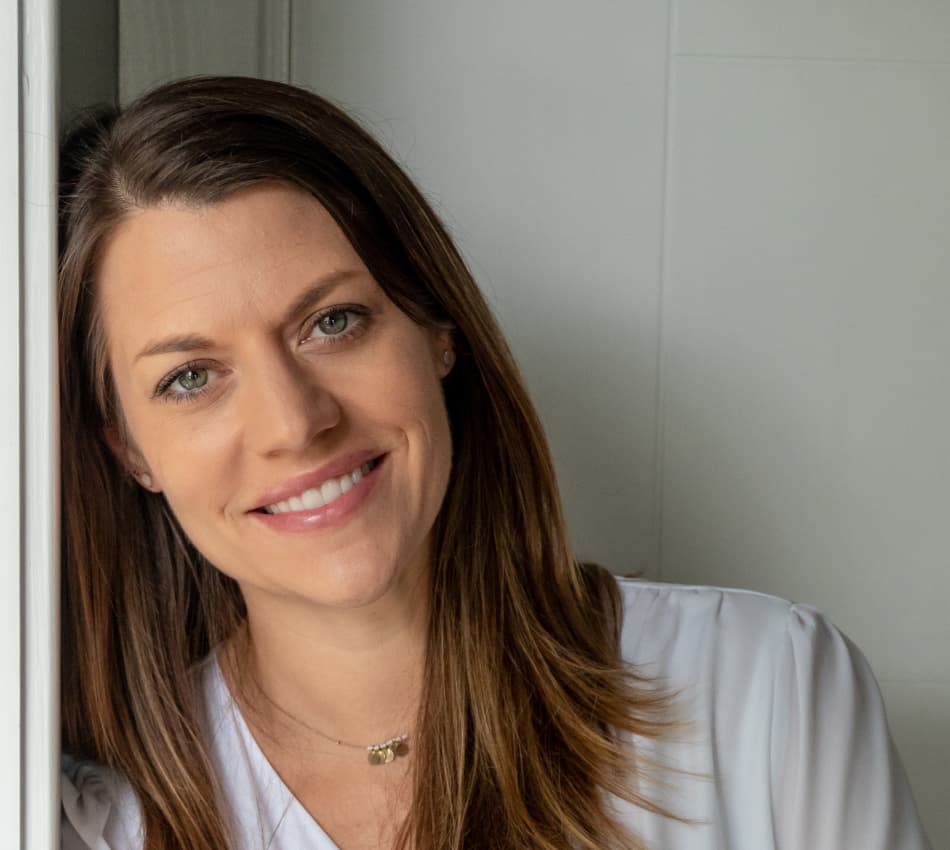Owning a small business is a journey. Every challenge you overcome is a step in the right direction. Every day is an opportunity to learn something new about your customers, your industry, your business, and yourself. Though every small business owner is different, there’s one thing all entrepreneurs have in common: unbridled passion.
But passion alone isn’t enough to build your business into something sustainable, then grow it when the time is right. Read on to learn how this Bluevine customer turned her passion into a successful interior design business at an opportune time—and get her best tips for how to accelerate your growth.
How CBH Interiors was born
When the Covid-19 pandemic hit in early 2020, Carissa Byrne Hebert found herself in a familiar spot for many entrepreneurs. She’d been working in interior design for more than 11 years, focusing mostly on commercial projects like offices and amenity spaces. But many workplaces were forced to shut their doors with no certainty of when they’d reopen, leaving the commercial market fairly dry for interior design projects.
Carissa had always been more interested in residential interior design and took on side projects in addition to her full-time job when she could. So, when the residential design industry started booming with people working from home, she decided to take advantage of the opportunity in front of her and do something she’d been dreaming about her whole life—Carissa started her own business: CBH Interiors.
CBH Interiors is a full-service interior design studio that specializes in home renovations. Carissa got the ball rolling quickly in late 2020, starting an LLC, building a website, and opening up a business checking account to keep her finances separate.
“Late 2020 was actually the perfect time to start a residential interior design business,” Carissa says. “People were sick of staring at their four walls and were desperate to make a change. Plus, virtual meetings became popular, so I was able to work on projects in places like Mississippi, Las Vegas, and even Alaska.”

According to Carissa, one downside to virtual consultations was that she needed to rely on her clients to take measurements and photos, which sometimes presented challenges and didn’t work for every project. Plus, she didn’t get to see the space for herself.
“Since interior design is such a personal service, I realized that I preferred meeting people in person. That way, I could physically go to their homes, get to know the clients on a more personal level, get a better feel for the space, and keep my client base local.”
As soon as things started to open up again toward the end of the pandemic, Carissa focused more on busy professionals in the Jersey City, Hoboken, and Greater NYC Area.
Being your own boss
Many entrepreneurs start their own business for the control and autonomy—it’s a popular dream to be your own boss, especially after working for someone else for years. But Carissa sees it a little differently.
“I enjoy the autonomy, yes. It’s not about being my own boss, though.” She pauses. “I went from having one boss to having 20,” she says, laughing. “It’s more about business and personal freedom. I’m a new mom, so having flexibility is more important to me now than ever.”
To Carissa, starting her own interior design business was about taking on the projects she was most passionate about and building her portfolio with projects she wanted to do. And, on the side, she has the flexibility to teach, too. In fact, Carissa currently teaches residential design courses at the New York School of Interior Design.
“Teaching is my way of giving back to the next generation of interior designers. It’s so important to have professors who are active in the industry. That’s something that made the biggest impact on me when I was a student at NYSID, and I hope I can help students in the same way.”
Finding your ‘why’
Whether you identify your ‘why’ when you first start your business or soon thereafter, it’s a necessary step in the entrepreneurial journey. You need to know your reason for doing what you’re doing, so you can keep going when times are tough. Business owners who have been at it awhile lean on their ‘why’ to drive everything they do.
For Carissa, it had always been a dream of hers to run her own business. But that alone isn’t what keeps her going.
“I thrive being around people and building relationships, so being in charge of my own projects and clients always came easy to me,” she says. “What I truly love to do is help my clients feel comfortable getting out of their comfort zone and confidently select materials and finishes that are unique, make a statement, and elevate their home.”
Since residential design is so personal, Carissa is able to get to know her clients very well. She gets close to them and recognizes their pain points and what they love. Seeing clients happy with the finished product is the most rewarding part of her work.
“The people make it so much easier to do this every day.”
When asked about her most memorable recent project, Carissa smiles. “Someone hired me to work on their kids’ bedroom. And we finished up when the kids were at daycare and school, so my client sent me a video of her kids seeing their room for the first time. It was adorable! That was the best ‘thank you.’”
The most common mistake small businesses make early on
Carissa echoes many other entrepreneurs in saying, “A lot of small business owners take on projects for free or don’t charge enough, especially interior designers.”
This is extremely common with new small businesses—it’s easy to get taken advantage of while you’re trying to build a customer base and get word-of-mouth referrals. However, as Carissa’s business coach taught her, your work is valuable and you need to charge what you’re worth.
She warns, “If you’re not valuing your time, then your clients aren’t either.”
Carissa recommends doing your research and knowing how much competitors in your area are charging. Being the least expensive option isn’t always best. Your pricing should reflect the value your service brings, and your work will speak for itself.

Similarly, for established businesses, it can be a good idea to reevaluate your pricing every so often. That way, you’ll be able to stay competitive in the market while optimizing your profit margins.
5 ways to help your business grow faster
1. Hire a business coach if you can
“One thing I didn’t have when I started was business experience. I’m much more comfortable with the creative side of things, but I needed to wear both hats.” Carissa educated herself by watching tons of YouTube videos, including helpful content from lawyers about how to file business documents and what types of insurance to consider.
She says, “Then I hired a business coach in 2021, which was key to growing my business, staying on budget, and putting systems in place to run projects smoothly.”
Experienced business owners can also serve as mentors for newer entrepreneurs, which helps set up the entire small business community for success.
2. Put yourself out there
Since starting CBH Interiors, Carissa has joined a networking group and attended numerous chamber of commerce events to meet officials and fellow local business owners. She even meets other entrepreneurs for coffee occasionally to talk shop and inspire each other.
“It’s important to make connections wherever you can—the more, the better,” Carissa says. “It’s the best way to grow your business.”
Strong connections with fellow entrepreneurs and your community remain valuable regardless of how big your business becomes.
3. Inspire others to spread the word
Typically, newer business owners start by spreading the word through friends, family, and contacts. But word-of-mouth marketing should always be part of your strategy, even if your brand turns into a household name.
“Referrals are the best source for leads and clients,” says Carissa. “You want to leave clients as happy as possible. Do such a good job that they need to tell their friends about it.”
4. Go where your customers are
When she started her business, one of the first things Carissa did was create a website. This is an essential channel to gain awareness and gather leads. It can be a good idea to learn as much as you can about SEO to see how you can incorporate optimization strategies into your marketing.
“Once you identify your audience, you should also consider where they spend their time—which social media channels would be most effective for you?” Carissa adds, “When you’re a small business owner, you are your business, so be sure to use both your business and personal social media accounts to promote what you’re doing.”
As your business grows, you can also use your personal accounts to track your journey as an owner. This transparency can help you inspire other small business owners and build a community for networking. For B2B brands, that awareness can be invaluable.
5. Make sure you have the right business checking account
“One of the things I learned from the lawyers on YouTube was not to commingle your money,” Carissa laughs. “Early on, you need to find a business checking account that’s set up to grow with your business. Find one that gives you the opportunity to earn high-yield interest, so you can make the most of your money.”
“For small business owners,” she adds, “you also want an app that’s easy to use. That could save you a lot of time as you’re trying to grow. Opening a Bluevine account was a no brainer!”
Carissa is a Certified Interior Designer, with over 15 years of interior design experience. Her varied experience working on both corporate and residential interiors has given her valuable insight into successfully running projects, managing relationships, and leading the renovation process. Carissa is an expert at helping clients decipher what they truly want and need in their space, as well as creating interiors that stand the test of time. Carissa and her team are ready and waiting to help you, too.
Learn more about Carissa’s work, and schedule a free consultation.
